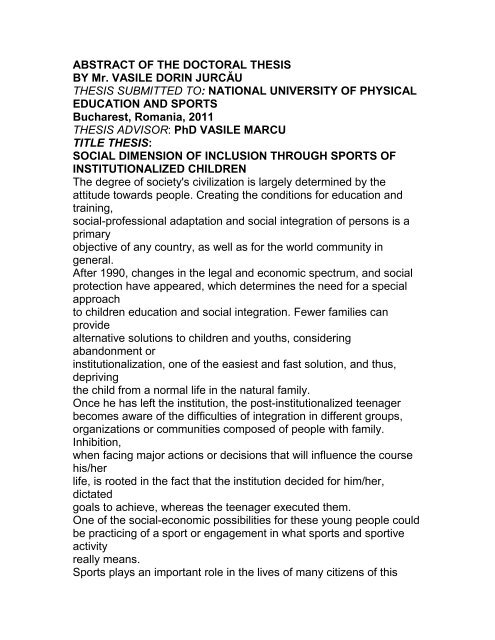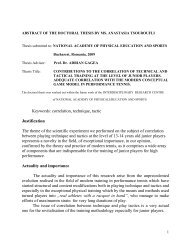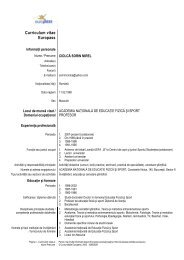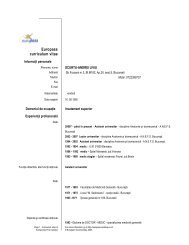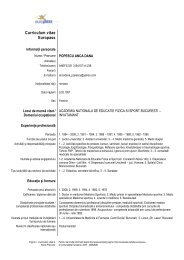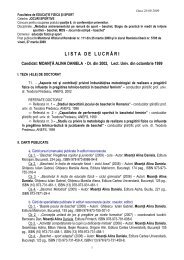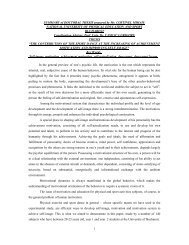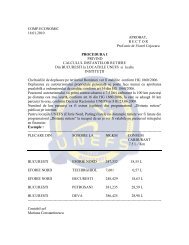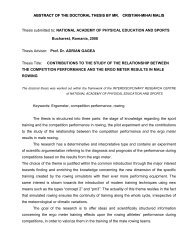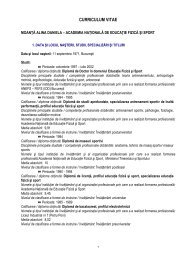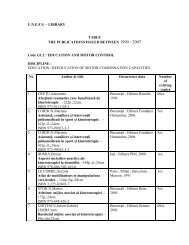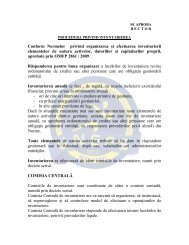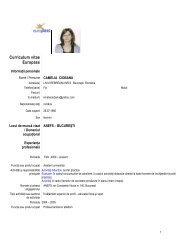ABSTRACT OF THE DOCTORAL THESIS BY Mr. VASILE DORIN ...
ABSTRACT OF THE DOCTORAL THESIS BY Mr. VASILE DORIN ...
ABSTRACT OF THE DOCTORAL THESIS BY Mr. VASILE DORIN ...
Create successful ePaper yourself
Turn your PDF publications into a flip-book with our unique Google optimized e-Paper software.
<strong>ABSTRACT</strong> <strong>OF</strong> <strong>THE</strong> <strong>DOCTORAL</strong> <strong>THE</strong>SIS<strong>BY</strong> <strong>Mr</strong>. <strong>VASILE</strong> <strong>DORIN</strong> JURCĂU<strong>THE</strong>SIS SUBMITTED TO: NATIONAL UNIVERSITY <strong>OF</strong> PHYSICALEDUCATION AND SPORTSBucharest, Romania, 2011<strong>THE</strong>SIS ADVISOR: PhD <strong>VASILE</strong> MARCUTITLE <strong>THE</strong>SIS:SOCIAL DIMENSION <strong>OF</strong> INCLUSION THROUGH SPORTS <strong>OF</strong>INSTITUTIONALIZED CHILDRENThe degree of society's civilization is largely determined by theattitude towards people. Creating the conditions for education andtraining,social-professional adaptation and social integration of persons is aprimaryobjective of any country, as well as for the world community ingeneral.After 1990, changes in the legal and economic spectrum, and socialprotection have appeared, which determines the need for a specialapproachto children education and social integration. Fewer families canprovidealternative solutions to children and youths, consideringabandonment orinstitutionalization, one of the easiest and fast solution, and thus,deprivingthe child from a normal life in the natural family.Once he has left the institution, the post-institutionalized teenagerbecomes aware of the difficulties of integration in different groups,organizations or communities composed of people with family.Inhibition,when facing major actions or decisions that will influence the coursehis/herlife, is rooted in the fact that the institution decided for him/her,dictatedgoals to achieve, whereas the teenager executed them.One of the social-economic possibilities for these young people couldbe practicing of a sport or engagement in what sports and sportiveactivityreally means.Sports plays an important role in the lives of many citizens of this
country and plays a prominent role in society, with great potential intermsof social inclusion through sport, which means that participation insportsand physical activities contribute in many different ways to inclusioninsociety; thus, inclusion in sport involves a combination of "sports forall",equal access to sport, equal opportunities in sports and varioussportsfacilities and opportunities to practice sports, depending on demand.Sports meet a multitude of social and educational functions, whosebenefits are much more visible as they are targeted in particular toteenagerswho represent their main target. It can be said with certainty that thesocialintegration of children is even stronger when they practice a sport thatbringsthem into direct contact with their peers.The thesis is divided into three parts, conclusions, practical andmethodical recommendations, bibliography.The first part includes two chapters where articles and specializedliterature are critically reviewed.The proposed study regarding the integration of institutionalizedchildren through sports, has initiated the groundwork for the study ofliterature that deals with peculiarities of psycho-motor growth anddevelopment of the child in general, and in particular, to capture theinstitutional features and individual age, the way various physicalprocessesand properties appear and manifests in human development ingeneral, andchild development in particular.In the second part of the paper is an analysis of needs of the childoverinstitutional integration through sports as a necessary first step inplanningeffective actions in terms of social needs of institutionalized children.Thus,based on a questionnaire applied to children who are the subject ofthe
present research work, were drawn some conclusions concerning theneedfor legitimate striking that these children have.The questionnaire contains seven items that contain applicableinquiries about the sports that institutionalized children practice orhavepracticed lately, through the practiced sports, understanding hereregularattendance at training within departments or clubs. Throughinstitutionalizedchildren in this case, we understand children without CES, able interms ofbio-psycho-motor skills to practice any specific exercises forperformance insports.The application of the questionnaire has revealed that from the 21interviewed children, 10 are still practicing a sport, 4 practiced a sportin thepast, 4 of them have attempted to practice a sport, and 3 have neverpracticed a sport for performance.Based on the questionnaire, two PEST and SWOT analysis havebeenmade, strategic analysis type that have served to identify the mostappropriate ways of action. Thus, one can draw some eloquentconclusionsbased on these analyses:- The legislation in force, governing compliance, promotion andsafeguarding of children rights in line with international requirementsinchild protection is a good thing, as well as decentralization of socialwelfareservices to children and their transition to the subordination of mayorsandmunicipal councils.- As opportunities, we have to mentioned the possibility of accessingexternal funding for social integration programs or donations andsponsorships to support disadvantaged children and to promotevolunteerismin working with disadvantaged children- Among weaknesses, we mention the need to find sources of funding
for employment programs to complement the daily program for thechildrenthat benefit form social protection, logistical means to supportchildrenaccess to sporting facilities or training specialists in this field whosepriorities are represented by the formative character of sport asopposed toperformanceThe largest amounts of treats are raised by the economic crisis, thuslowering the populations’ standard of living, which is also reflected inthelife of disadvantaged children; from a social point of view, thedifficultiesthat institutionalized children have in relating with other children fromnormal families or sport professionals reluctance to institutionalizedchildrenIn the second section, there are also treated aspects of the place androle of sports in shaping institutionalized child's personality.Physical education is an indispensable component in the formation ofpersonality. Its importance has been highlighted since ancient times.Itstheory and practice have evolved upwards, as determined byhistoricalcircumstances and social-historic conditions.The formative and auto-formative valences of physical education,especially its contribution to the formation of will and character traits(courage, strength, tend to improve, perseverance, tenacity, spirit ofinitiative, independence, etc..) can be transferred through the masteryofteacher (coach) to other self-education areas - intellectual, moral,aestheticself-education. Finally, physical education plays a critical role not onlyinthe physical body but also in the formation and self development ofpersonality in its many aspects.Sports movement can play an important role in matters of publicinterest and social inclusion. In this context, professional athletes andamateur athletes and sports clubs are models for society, especiallyyouth
and sports organizations and civil society organizations, whose objectofactivity is sport, also contribute to the integrationThe last part refers directly to the child institutionalized integrationthrough sports, by identifying the types of relationships withinstudents’groups in which the inclusive education of institutionalized children isobtained, and who practice or have practiced a sport. Taking aboutthe groupin a more analytical way, with tools of the social-metric method, wetried toidentify the attitudes of attachment or rejection of students at schoolof insociety through sports.The study is based on applying a social metric investigation, on somegroups of students from schools in Baia Mare, where they operate asstudents, children who are subjects of this research, in February of2011.By processing the results, it was mainly aimed at social status (S)expressed numerically, that determines the Range (R) of eachindividual inthe group.The results have confirmed the hypothesis of the study, that is,practicing sports makes the integration of institutionalized childreneasier.Thus we could draw the following general conclusions:• those who practice or have practiced for a time a branch of sport,scored a higher social-metric status index, which ranks them in thetopin the community ranking;• there is a significant difference between children who practiceindividual sports and those who practice physical activities in teamsports;• the more frequent team sports are practiced, the more likely it isthatsubjects develop positive attitudes toward teamwork. Those whooftenpractice team sports, are also more opened to forming friendlyrelationships
• from the needs analysis, certain reasons of abandonment of sportpractice have emerged, this being mostly done independent of theirdesire. Here are: lack of financial support under self-financing privatesports clubs, big distance to sporting facilities and improper trainingschedule, the attitude of specialists in sports performance and whoseek only to remove children who are not considered viable for highperformance.Recommendations:• early supervision of these children in order to achieve selection forsports on a scientific basis as appropriate to age and sport they wanttoactivate, and eventually to be able to shift to another branch of sport;• preparation of specialists and their awareness, in terms of practicingsport for its formative effects and not necessarily for performance• going over the performance goals of any sports, the purpose can bematerialized through preparing for independent living, for the momentwhen children leave the institution, as well as for a job that can berelated to sports


